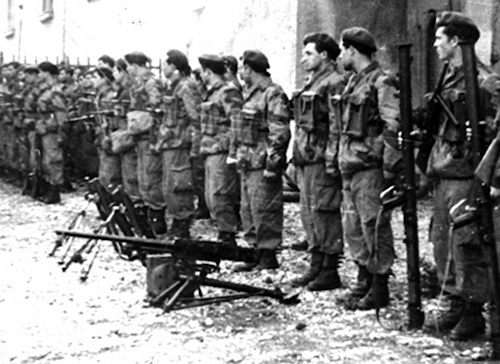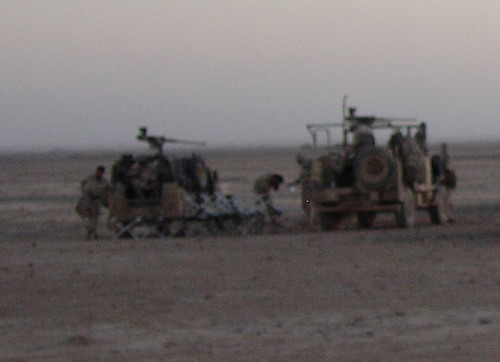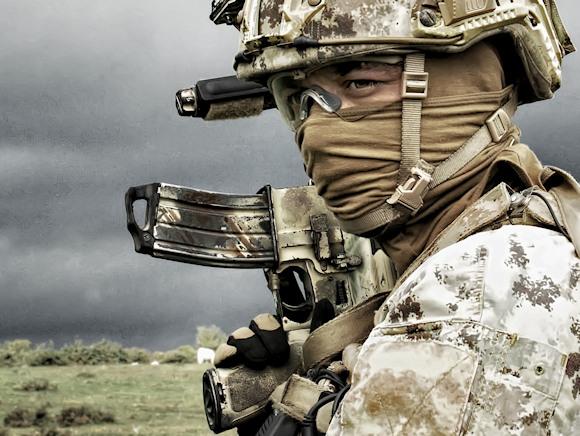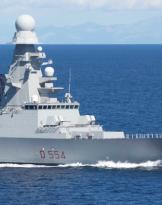Established in Rome on 1 December 2004 (at the Francesco Baracca barracks), the COFS (Joint Command for Special Forces Operations), initially, it had the objective of coordinating the missions of the two defense special forces departments: the 9th assault rgt With Moschin of the Army, framed at the time in the paratroopers brigade thunderbolt, and the GOI of the Navy framed in the Diving and Inshore Command (COMSUBIN).
Both the Collar Moschin that the GOI had already operated on several occasions together as in Somalia in 1993 or for the evacuation of compatriots in Rwanda and, in November 2004, for the evacuation of compatriots in the Ivory Coast. Furthermore, the two departments had known each other for decades because, after the war, the aspiring raiders of the army and navy shared some phases of the training process, such as parachuting training (carried out in Pisa at the CAPAR) or diving (at COMSUBIN, the only military body authorized to issue the patent in this sector). Not to mention that, until the end of the 70s, some of the Col Moschin saboteurs attended the complete course of the navy raiders, achieving the qualification of "naval raider" because, since that time, the aquatic component was also of significant importance. for Army saboteurs who, immediately, equipped themselves with a base dedicated to this domain by digging it and building it with their own hands at the mouth of the Arno river.
Meanwhile, the other two armed forces (Aeronautica Militare and Carabinieri) have also begun to invest in special departments.
The Arma Azzurra decided to reactivate a special department, initially called RIAM (Military Air Force Incursors Department) which originated from the Arditi Destroyers of the Regia Aeronautica (ADRA). The carabinieri, elevated to the rank of Armed Force, identified the GIS (Special Intervention Group) as a unit of special forces, also qualifying the operators with the raid license.
In 2005 both departments were made available to the COFS for possible use and, from that date, the Defense had a Special Forces department for each Armed Force.
Therefore, the four departments mentioned above, from an employment point of view, would henceforth be under the command of the COFS which would take care of their deployment in out-of-area missions. The COFS, in fact, was created as a Joint Command to the COI (today "COVI") with which it would coordinate, if necessary, for all those missions that would have contemplated the use of conventional forces and assets in addition to the use of Forces Specials.
The newly established COFS was immediately put to the test with 2 important commitments.
Firstly, in 2006, with a real operation, that is, the “Sarissa” operation which contemplated the deployment and use of the now famous Task Force 45 in Afghanistan.
At the same time, the COFS was engaged with a commitment in the sphere of Allenaza. Italy, in fact, had committed with NATO to provide the command of the Special Operations component CJSOTF (combined Joint Special Operations Task Force) within NATO Response Forces.

In 2008, after a validation process lasting about a year, the COFS has been certified by NATO as a Component Command for Special Operations under the NRF (NATO Response Force). SOCC (Special Operations Component Command) is the Component Command responsible for the design, planning, organization, conduct and coordination of OS (Special Operations) in one or more specific theaters. This articulation is by its nature inter-force, moreover, in multinational contexts, it can take on the connotation combined.
On a national level, the COFS is the only Command in charge of planning, organizing and conducting Special Operations and, therefore, constituting the framework (structure) of the SOCC, or of the Combined Joint Special Operations Task Force (CJSOTF - similar structure for functions but more streamlined than the SOCC) placed directly under the COMINFOR, or joint commander (Joint Force Checkout). In this context, the commander of SOCC (COMSOCC) holds the appropriate level of command authority delegated by COMINFOR.
It should be remembered that the COFS commander is also an advisor to the Chief of Defense for all aspects concerning Special Operations. It also assists the political-military leaders in operational decisions in this specific sector, deals with the procurement of materials to be adopted by the special departments, on the basis of specific needs expressed by the departments themselves.
Meanwhile, the rangers of the Monte Cervino they had been elevated to the rank of regiment (4th Regiment Ranger Monte Cervino), while since 2000, the 185th Reg. paratroopers artillery thunderbolt had started the process for converting the acquisitions of objectives into a regiment. Already in 2005, with an initiative that seemed rather premature to us, the then Chief of Staff of the Army Giulio Fraticelli tried to bring these departments back into the Special Forces. The conversion processes of both units were, in fact, still at the beginning and, as far as we can understand the ambition of the Army, it is difficult for us to understand how, in just a few years, they managed to transform into Special Forces operators Alpine infantrymen and artillerymen if not with "amnesty" courses and early qualifications. In addition to the new recruits, it was necessary, in fact, to educate those who had been an Alpine infantryman and gunner for decades, albeit paratroopers, having to change mentality and acquire new complex notions, as well as requiring much higher physical and professional standards, even to those who often he was no longer at an early age, if not three quarters of his career.
This process was entrusted to the supervision of the Initial Training Unit of the Army Special Operations Forces Command which settled in Florence, in the Predieri barracks starting from the early 2000s and to whose command never was an officer with proven experience in the field of Special Operations deployed. We understand, in fact, that this structure, which then evolved into Office as part of the Command of the Terrestrial Operational Forces in Verona, it was commanded by Colonels D'Apuzzo, Morena and Loiacono who had never had previous careers or experiences, even if only episodic, in the raiding departments. Even the staff of this Nucleus was essentially composed of paratroopers who did not have any specific experience or expertise of the particular "Special" component. In 2005, at the request of General Fraticelli, the chief of staff of the defense protempore, admiral of Paola, responded with a vibrant denial, however ensuring, as is customary on these occasions, the utmost attention to the initiative of the Army.
But what is meant by special departments?
In recent years, on a national level, the term "special" has lent itself to numerous interpretations, ie many departments claim their own specificity but this is not enough to place them within the Special Forces in the strict sense.
 Public opinion often misleads the correct definition of special department, attributing to it connotations exclusively of "physicality" (as is often seen in the videos of some eastern countries, where FS soldiers appear engaged in breaking piles of tablets with unlikely and equally scenic karate moves with their hands and feet).
Public opinion often misleads the correct definition of special department, attributing to it connotations exclusively of "physicality" (as is often seen in the videos of some eastern countries, where FS soldiers appear engaged in breaking piles of tablets with unlikely and equally scenic karate moves with their hands and feet).
Special Forces operators must be able to ensure ability to enter non-permissive contexts (across the three dimensions), so as to be able to carry out sabotage tasks, hand strikes, capture of important personalities, area interdiction as well as hostage release operations.
In particular, the traditional OS in the NATO context are divided into DA (Direct Actions), SR (Special Reconnaisance) and MA (Military Assistance), the latter not necessarily the prerogative of the FS alone. In Italy these 3 tasks are integrated by 4 missions of exclusive national prerogative approved by the head of the SMD.
The OS, moreover, have the characteristic of being conducted in depth in the adversary device (in any case in a non-permissive context), in isolation and independently, usually in hidden or discrete conditions. In practice, these are operations that require small forces with a very high degree of professionalism, self-sufficiency and initiative.
The fundamental element that must necessarily characterize the units of the sector should not be overlooked, namely the ability to conceive, plan, conduct and coordinate those tasks envisaged by the Alliance and of exclusive national prerogative which together constitute the horizon within which the Special Operations.
Clearly, in addition to planning capacity, the ability to support these activities in total autonomy is also required. Given the sensitivity and discretion of the OSes, in fact, the departments cannot depend on other bodies for the materials and equipment necessary for their use. Precisely for this reason, for example, both the 9th regiment and the GOI have their own parachute park that they manage independently through a folding room inside the department.. The same can be said for the underwater equipment that the two departments have the ability to maintain, recharge and repair using, in total autonomy, equipment and structures that are also particularly sophisticated, innovative and expensive.
Finally, although not contemplated by any doctrine or legislation, we introduce a characteristic that in our opinion must necessarily characterize these departments, that is, the CHROMOSOMIC aspect. As one of the truths of the Special Forces states, these departments are not created at the last moment. Nor can they be established with a simple "decree" or by changing their name "Tout court" to other units with completely different backgrounds and traditions.
 These departments are all characterized by a particular GENOME that is configured with history, with the operations conducted, with dead men in training, with experiments. gone bad, with the particular sense of camaraderie and belonging that over the decades has been created among those who have always unconventional. Whether it is the torpedo boats of Commander Rizzo and the Arditi of Major Messe, these departments have their roots in history by descending directly, and not by late and original decision of a general staff, from those who more than a hundred years ago tried their hand, first in history, in what is considered by many to be the origin of Special Operations.
These departments are all characterized by a particular GENOME that is configured with history, with the operations conducted, with dead men in training, with experiments. gone bad, with the particular sense of camaraderie and belonging that over the decades has been created among those who have always unconventional. Whether it is the torpedo boats of Commander Rizzo and the Arditi of Major Messe, these departments have their roots in history by descending directly, and not by late and original decision of a general staff, from those who more than a hundred years ago tried their hand, first in history, in what is considered by many to be the origin of Special Operations.
Some hints on the (re) birth and missions of the Special Forces.
The Army raiders were born in 1953, when the Special Platoon. The 1947 Peace Treaty prohibited the Armed Forces from setting up special units, however, with the onset of the Cold War and the entry of our country into the Atlantic Alliance, these ties became less rigid.
The beginnings were certainly not easy as, while acknowledging the importance of special operations, the appropriate equipment and doctrines were lacking.
When it was possible to form an operating company, it was divided into three components:
- Industry
- Inland waters
- Mountain
Industry had to deal with the sabotage of industrial complexes. Acque Interne was to operate against bridges and in the inland waters of the northern Adriatic. The Mountain saw its field of use in the Eastern Alps.
It should be remembered that the enemies at the time were Tito's Yugoslavia and the forces of the Warsaw Pact.
The very first exercises saw the raiders set sail from the seaplane base of the Lido of Venice aboard thin units of the Navy, after which the raiders launched the canoes off the coast of Trieste and paddled to land, where they simulated an action and then return to the boats. Already at the time the base cell of the raiders was the couple. Obviously, the entire department was wrapped in a curtain of confidentiality, as the special departments were considered a precious resource for each individual country.
The first operational use took place to counter South Tyrolean terrorism in 1966, carrying out patrol tasks in strategic points, such as the Brenner railway and high-altitude surveillance activities.

In 1967 the first heroes of the saboteurs department fell in Cima Vallona following a bomb attack by separatist terrorists (v.articolo). They were second lieutenant Mario di Lecce and sergeant Olivo Dordi, the first to fall in post-war operations as part of a counter-terrorism activity in which the department saboteurs he was immediately employed (together with paratroopers carabinieri).
In 1975, as part of the reform of the Army, the battalion saboteurs took the name of 9th parachute assault battalion With Moschin.
Missions abroad began in the 80s, first in Lebanon (1982-84), with missions Lebanon 1 and Lebanon 2; in 1991 in Iraqi Kurdistan, where the raiders carried out prolonged operations together with the American Special Forces, in front of the outposts of Saddam Hussein's forces; in Somalia (operation Ibis., 1992-94) the operators of the Collar Moschin they played an important role, carrying out a wide range of special operations (and not only those).
On 2 July 1993, the sergeant major incursor Stefano Paolicchi, the third member of the special forces to fall in combat since the end of the Second World War, was killed in combat. Together with the other raiders, Paolicchi was busy neutralizing the fire centers around the Checkpoint Pasta in Mogadishu.
In the same period of the mission in Somalia, the raiders of the Nono - together with the GOI operators of the Navy - they also had to cope with the extremely difficult mission Hippocampus, that is the evacuation from Rwanda of hundreds of our compatriots, blocked in the country devastated by the civil war (the term tribal war would be more appropriate) in which thousands of people were literally torn to pieces.
Meanwhile, another peacekeeping operation began, this time in the Balkans. The Collar Moschin he was at the head of the Italian contingent (based on 8th Bersaglieri Brigade Garibaldi) which entered Sarajevo, the capital of Bosnia, in 1995, destroyed by Serbian artillery. The tactical context was less dangerous than the Somali one, however the local militias were better organized and armed (not to mention the threat posed by depleted uranium ammunition, widely used in bombings against Serbian forces).
And anyway the Nono carries out special operations in all respects, first dealing with inter-entity separation in the Gorbavita neighborhood in Sarajevo and then moving its main activities to Pale where the government of the Serbska republic was located and where Karadzich lived.
In 1997 the Albanian emergency broke out, the Nono with the GOI they contribute to the evacuation of Italians and foreigners from the fiery Valona. Later they take part in the international mission Alba, under Italian leadership, for the stabilization of Albania.
 Non-combatant Evacuation Operations (NEO) from civil war-torn countries, in the last thirty years, from Somalia to Yemen to Libya, they have been led by small detachments of the Nono (sometimes together with the GOI raiders) who guaranteed an indispensable security framework for the aircraft in charge of evacuating Italian citizens and other nationalities, also providing protection to diplomatic offices.
Non-combatant Evacuation Operations (NEO) from civil war-torn countries, in the last thirty years, from Somalia to Yemen to Libya, they have been led by small detachments of the Nono (sometimes together with the GOI raiders) who guaranteed an indispensable security framework for the aircraft in charge of evacuating Italian citizens and other nationalities, also providing protection to diplomatic offices.
In the most complex evacuations, the operative detachments of the raiders are physically due to go to retrieve their compatriots around the country or in the collection centers provided for by the plan Hippocampus, often in non-permissive contexts and moving under the looming threat of both rebels and government forces. Sometimes they have had to use “makeshift” vehicles and equipment and adapt to absolutely unpredictable situations. In these situations, the ability to understand and interpret the operating environment was fundamental considering the unbalanced balance of forces put in place and the scarcity of means and support on which the raiders could count.
In addition, there have been periods of continuous engagement in several operational theaters, as in 2003-2006, with the missions in Iraq (Ancient Babylon) and Afghanistan, which required a particular commitment also given the limited number of raiders. Furthermore, again from 2006 to 2007 the 9th gave birth to one Special Operations Task Group also in the context of the international mission in Lebanon.
In summary, in 2006 the ninth regiment simultaneously supplied the framework of three Special Operations Task Groups, one employed in Iraq, as part of the operation Ancient Babylon, one in Afghanistan - the famous Task Force 45 - and one in Lebanon as part of the international mission established there.
The raiders of the Nono they arrived in Afghanistan in December 2001, when the Italian ISAF mission was still confined to the capital Kabul. In 2003, the Berlusconi government decided to send a contingent under the Enduring Freedom (Kite 1 and Kite 2), destined for the Khowst area, near the border with Pakistan. The raiders of the Collar Moschin they worked jointly with the GOI, developing and fine-tuning the first operations in a hostile context.
The special forces of Kite they found themselves operating in a very difficult environmental context, with road conditions that were problematic to say the least and an adversary who could count on relatively safe foundations. The operational detachments, composed of raiders of the Nono and the GOI, also carried out missions close to the Pakistani border, using national and American rotary-wing aircraft, as in Khowst there was a base of special forces (Green Berets).
As previously mentioned, the ISAF mission initially concentrated exclusively in the Kabul area, while in the rest of the country it operated Enduring Freedom.
 When the ISAF mission was extended to all of Afghanistan - dividing the territory into Regional Commands - Italians and British created a Joint Special Forces Command: SOCCE (Special Operations Command and Control Element - which will later evolve into Special Operations Component Command) which at the beginning was composed of Task Force 42 (British) and Task Force 45 (Italian). All the special operations conducted in the theater were conceived, planned and conducted by this Command, to which Italy gave rise, and which then, as mentioned, evolved into the NATO Special Operations Command, incorporating the Special Forces, including American and many other nations. Under this command were the Special Forces Task Forces that did not depend in any way on the Regional Commands who, instead, conducted the conventional battle. It is evident that coordination mechanisms existed between the special structure and the conventional one, but there has never been a mixture of command lines, as it would be deleterious to create.
When the ISAF mission was extended to all of Afghanistan - dividing the territory into Regional Commands - Italians and British created a Joint Special Forces Command: SOCCE (Special Operations Command and Control Element - which will later evolve into Special Operations Component Command) which at the beginning was composed of Task Force 42 (British) and Task Force 45 (Italian). All the special operations conducted in the theater were conceived, planned and conducted by this Command, to which Italy gave rise, and which then, as mentioned, evolved into the NATO Special Operations Command, incorporating the Special Forces, including American and many other nations. Under this command were the Special Forces Task Forces that did not depend in any way on the Regional Commands who, instead, conducted the conventional battle. It is evident that coordination mechanisms existed between the special structure and the conventional one, but there has never been a mixture of command lines, as it would be deleterious to create.
The creation of the TF-45 had already been decided by the Berlusconi government in 2006. The political elections in the same year saw the affirmation of a center-left parliamentary majority which however carried out the organization and deployment of the unit in the theater, while maintaining the confidentiality of the activities. The discretion on the operations and on the very existence of the Task Force 45, it was in fact absolute! The unit was under NATO command line via Special Forces Command (he had no command connection with the Regional Command West or Regional Command Capital on which all the Italian conventional units depended) and reported directly to the COFS.
Only later was nature discovered extremely kinetic of the activities of Task Force 45 which, together with the other Alliance Special Forces units, had the main task of neutralizing the leadership of the insurrection.
Based on the availability of personnel, the TF-45 was divided into three components:
-
The Command in Herat, together with the logistics component.
-
Task Group Alpha based in Herat made up half by staff of the Nono, while the other half was made up of elements of the GOI, the GIS and the 17th wing of the Air Force.
-
Task Group Bravo, based in Farah, entirely composed of raiders of the Nono.
 The TF-45 has often availed itself, in operations, of the support of units of the 4th Rgt Ranger Monte Cervino which carried out the very important task of supporting in carrying out saturation, isolation of objectives, preventive occupation of positions and fire support.
The TF-45 has often availed itself, in operations, of the support of units of the 4th Rgt Ranger Monte Cervino which carried out the very important task of supporting in carrying out saturation, isolation of objectives, preventive occupation of positions and fire support.
Our raiders, in Afghanistan, have mainly conducted operations to identify and eliminate hostile militia groups (insurgents) focusing their attention on the leadership and on the prominent figures of the insurgency. Immediately after the capture or elimination of a target, the intervention of a more substantial unit, heavily armed, capable of encircling the area and allowing the exfiltration of the raiders in a security setting, could become necessary. This in fact should be the raison d'être of a department like the Monte Cervino.
The 185 ° RRAO was also present in the theater, not included in the TF-45, as the special forces operators already possessed autonomous capabilities for designating targets to air carriers (FAC, Forward Air Controller) and, of course, were able to conduct in-depth reconnaissance operations. The acquirers were placed in the Task Force Victor, whose activity depended on the Regional Command West and was included in the conventional command chain which, as we have already described, was distinct and separate from the "special" one. Furthermore, the TF Victor he had no connection, contact or dialogue with the COFS precisely because it referred to the conventional sector of operations.
In this brief (and incomplete) overview of the use of Italian special forces in various operational theaters, a strong component joint, then formalized and further accentuated with the creation, in 2004, of the COFS.
Another essential factor that must emerge is the importance of the special operations support component, without which it would not be possible to conduct any mission. In Afghanistan, for example, helicopter support (provided by the 3rd REOS of Viterbo) was fundamental, thanks also to the introduction of carriers such as the CH-47F and UH-90.
Concerning the creation of the COMFOSE (Army Special Forces Command) there are many doubts, as a Command has been created that has no operational use by replicating a structure very similar to the other Army brigades. The ternary structure of the conventional brigades, i.e. three basic weapon regiments, one for combat support and one essentially dealing with logistics, seems to have inspired those who, with little imagination, he designed the COMFOSE giving it an essentially conventional “line”. It would be much more interesting, in our opinion, to concentrate in a regiment, which could take on the connotation of a grouping, all the operational component of Special Forces and to introduce within the superordinate structure, or what is now called COMFOSE, an important, substantial is heavy dedicated support component which includes flight support, broadcasting, electronic warfare, Intelligence Surveillance & Reconnaissance completing it all with a true Innovation, Research and Development Department which should be the engine of the progress of the Italian Special Forces.
But on these our "crazy" ideas it is worth spending a few more lines in a future article ...
Photo: Navy / US DoD / web / Italian Army / author












